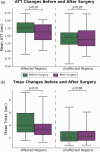Characterizing pre- and post-operative cerebral blood flow and transit time in pediatric moyamoya patients using multi-delay ASL and DSC MRI
- PMID: 40665679
- PMCID: PMC12267206
- DOI: 10.1177/0271678X251358979
Characterizing pre- and post-operative cerebral blood flow and transit time in pediatric moyamoya patients using multi-delay ASL and DSC MRI
Abstract
Cerebral blood flow (CBF) and transit time are essential biomarkers for assessing brain health. While dynamic susceptibility contrast (DSC) MRI has been widely applied to measure these metrics, it is limited in the pediatric population due to the need for contrast agents. Arterial spin labeling is a non-invasive and quantitative MR modality, and multi-delay ASL can measure CBF and transit time simultaneously. Although multi-delay ASL has been used in adult neuroimaging studies, its application in children requires investigation. Moyamoya disease, a progressive steno-occlusive cerebrovascular disorder, often manifests in childhood. In this work, we present a cohort study that examines multi-delay ASL and DSC MRI to characterize vascular hemodynamics in 22 pediatric patients. We evaluate CBF and transit time in different brain regions before and after revascularization surgeries. Results show that revascularization significantly increased CBF by 24% and 7.6%, respectively, as measured by ASL and DSC; it also significantly decreased transit time by 12% and 15%, indicating improved hemodynamics and metabolism. ASL and DSC results also showed significantly positive correlations in all brain regions. Thus, revascularization improved hemodynamics in pediatric moyamoya patients and shows that multi-delay ASL can effectively characterize CBF and transit time in the pediatric population.
Keywords: Cerebral blood flow; arterial spin labeling; arterial transit time; dynamic susceptibility contrast; moyamoya disease.
Conflict of interest statement
The author(s) declared the following potential conflicts of interest with respect to the research, authorship, and/or publication of this article: Gary Steinberg is a consultant for SanBio, Zeiss, and Surgical Theater, and receives royalties from Peter Lazic, US. These potential conflicts of interest are unrelated to the current study.
Figures





Similar articles
-
Comparison of Dynamic Susceptibility Contrast and Arterial Spin Labeling MRI Perfusion in the Assessment of Stroke and Steno-Occlusive Disease: A Systematic Review and Meta-Analysis.Diagnostics (Basel). 2025 Jun 21;15(13):1578. doi: 10.3390/diagnostics15131578. Diagnostics (Basel). 2025. PMID: 40647577 Free PMC article. Review.
-
Arterial spin labeling MRI in patients undergoing carotid artery revascularization: a systematic review of the hemodynamic changes and clinical implications.Eur Radiol. 2025 Aug 6. doi: 10.1007/s00330-025-11885-7. Online ahead of print. Eur Radiol. 2025. PMID: 40767871 Review.
-
Noninvasive dynamic vascular imaging: arterial spin labeling-based noncontrast magnetic resonance digital subtraction angiography for cerebral disease diagnoses.Jpn J Radiol. 2025 Jul;43(7):1049-1065. doi: 10.1007/s11604-025-01758-w. Epub 2025 Mar 12. Jpn J Radiol. 2025. PMID: 40072717 Free PMC article. Review.
-
New Classification of the Degree of Cerebrovascular Insufficiency in Patients with Moyamoya Disease Measured According to ASL-MRI Perfusion.Acta Neurochir Suppl. 2025;136:121-127. doi: 10.1007/978-3-031-89844-0_15. Acta Neurochir Suppl. 2025. PMID: 40632262
-
Revascularization improves vascular hemodynamics - a study assessing cerebrovascular reserve and transit time in Moyamoya patients using MRI.J Cereb Blood Flow Metab. 2023 Nov;43(2_suppl):138-151. doi: 10.1177/0271678X221140343. Epub 2022 Nov 20. J Cereb Blood Flow Metab. 2023. PMID: 36408536 Free PMC article.
References
-
- Teo M, Abhinav K, Bell-Stephens TE, et al. Short- and long-term outcomes of moyamoya patients post-revascularization. J Neurosurg 2022; 1: 1–11. - PubMed
LinkOut - more resources
Full Text Sources

